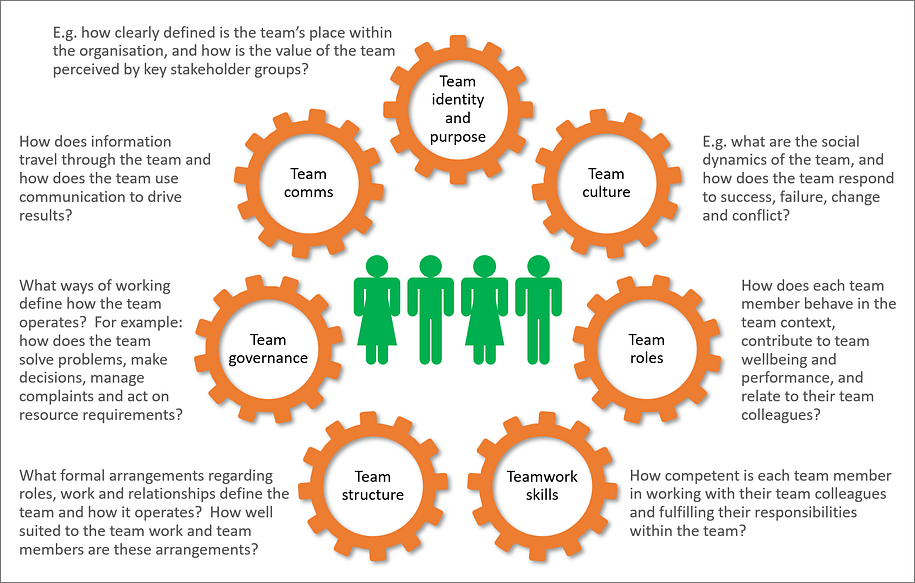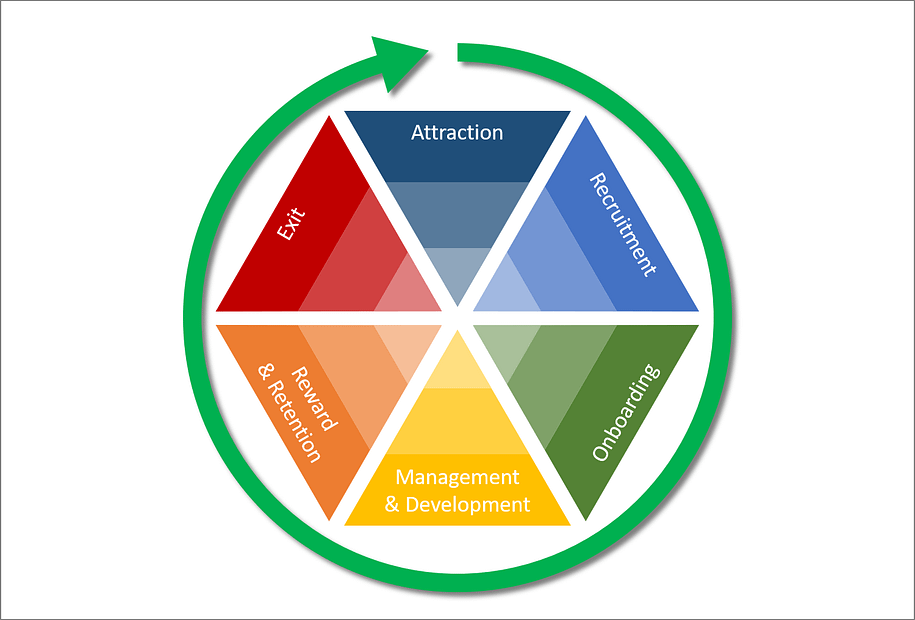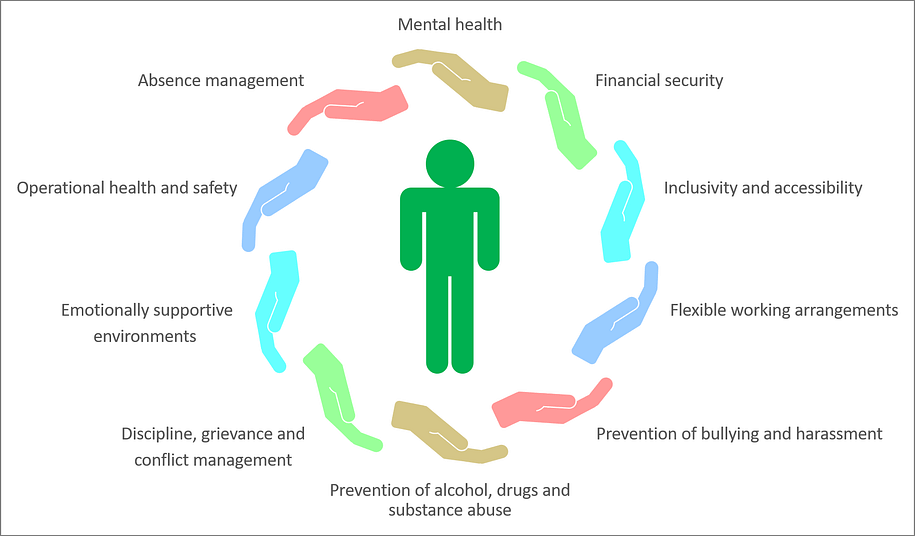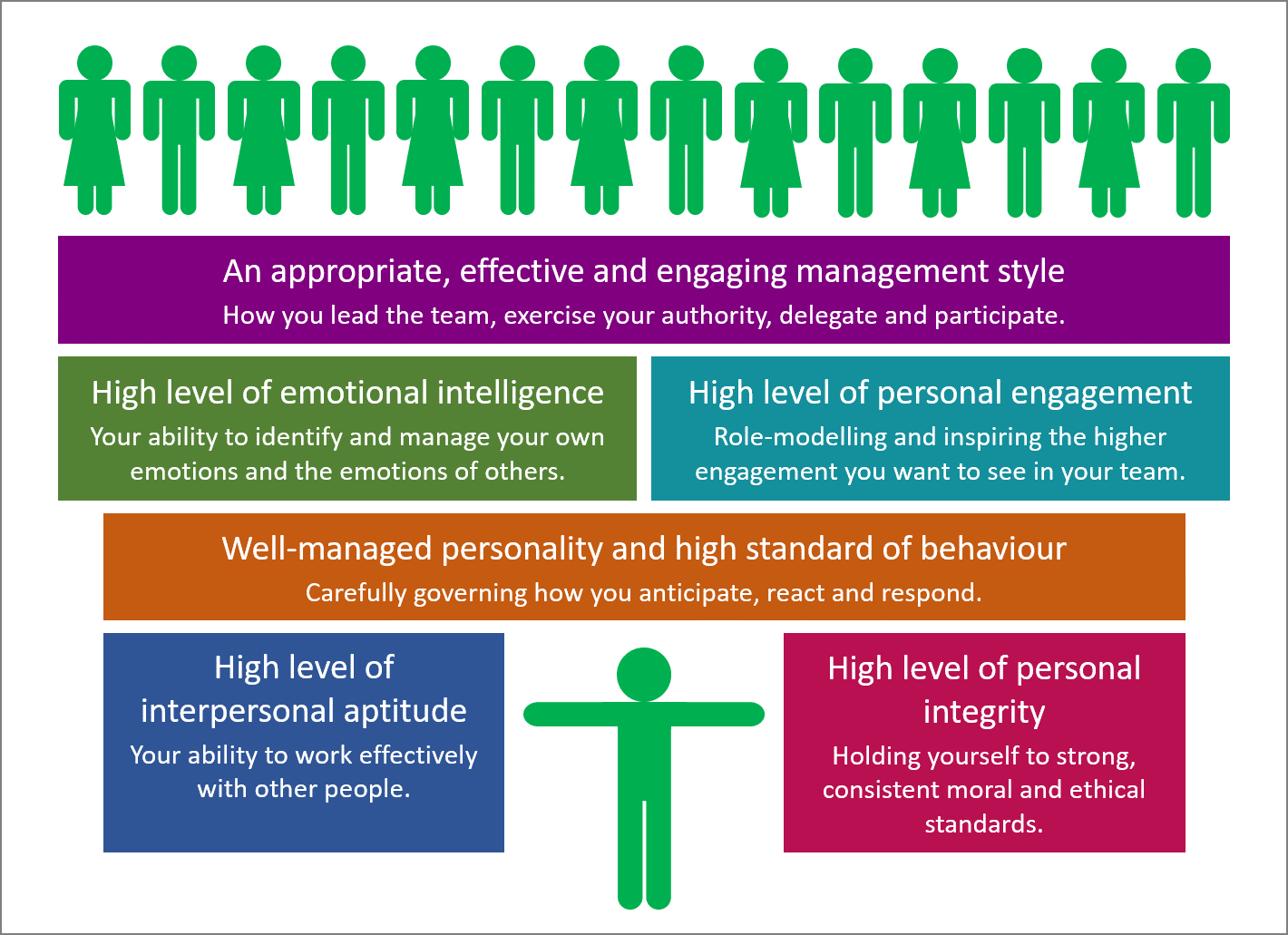
PART 5 - YOUR LOCAL DRIVERS OF ENGAGEMENT
Introduction: Take control of people management
In Part 4 we looked at how you and your team inhabit a complex engagement ecosystem, subject to many factors beyond your immediate control or influence. However, there are many aspects of the individual and team experience that are entirely yours to own and manage.
In Part 2, we looked at the ‘four enablers’ – the key factors we consider essential for effective employee engagement:
- Strategic narrative
- Organisational integrity
- Engaging managers
- Employee voice
These are the critical, high-level drivers of engagement that run through the veins of the engaging organisation. If managed effectively, they can have a profoundly positive impact on levels of engagement throughout the workforce.
Your local drivers of engagement are your principal areas of people management responsibility and control. Understanding them and how to apply them is key to being an engaging manager. Think of them as levers you can pull or dials you can turn to help create the conditions that drive engagement and maximise employee contribution. Managed well, they can be just as effective as the four enablers.
In Part 2, we also recognised that ‘engaging management’ means:
- strong management capability;
- providing clarity for what is expected from individual employees;
- treating employees as individuals;
- ensuring that work is defined efficiently and effectively; and
- taking personal and professional ownership of employee engagement.
But what does that all mean in practical, actionable, everyday terms?
‘Standard’ engagement drivers are often categorised at a relatively high level, grouping and summarising more granular detail for organisational leadership. Whilst there is value in reviewing broad strategic themes for the organisation, for our purposes we’ve grouped all the relevant factors together into the following five categories:
- Local team mechanics
- The employee lifecycle
- Employee wellbeing
- You, the people manager
- Engaging remote teams
Local team mechanics
A team is not a self-fulfilling solution. Drawing a circle around a group of people and labelling them a ‘team’ does not make them a team, and it certainly doesn’t make them an effective one.
Your team – the group of people reporting to you – is your responsibility, including how it functions and how well it functions. A team that functions well performs well and is more likely to achieve higher levels of engagement.
But teams are not automatically effective. They require planning, management and monitoring. Without due care and attention, teams can deteriorate into dysfunction. A dysfunctional team performs poorly – at the mercy of complexity, inefficiency, conflict and groupthink – and is fertile ground for disengagement.
You may be familiar with the Tuckman model of the team lifecycle and performance curve, which defines several stages of team development: forming, storming, norming and performing. In the ideal end state, the role of the team leader – your role – becomes virtually redundant.
Team managers often make one of two mistakes:
- They assume their team leadership role is virtually redundant before the team has reached an appropriate level of maturity.
Or, if their team has reached an appropriate level of maturity:
- They assume their virtual redundancy allows them to abdicate all responsibility for the team.
The engaging manager leads the team with fair management and firm support. They will only retract their leadership for the benefit of team development, and never take their eyes off team engagement and performance.
A team is more than the sum of its parts
There is more to a great team than the people in it. Think of your team like a miniature organisation in its own right. Everything the parent organisation needs is also required by the team, albeit on a smaller scale – identity, purpose, culture, structure and ways of working.
With adequate, managed provision for these requirements, not only will a team be well-equipped, well-organised and well-positioned, it will also benefit from cohesive, constructive and productive team dynamics – positive psychological undercurrents that promote engagement and influence team behaviour. Meeting the needs of the business is in balance with meeting the needs of the team and its members. Team members are more likely to feel included, supported, aligned, enabled and proud of the team and their collective contribution to organisational goals.
In the diagram below, we feature what we consider to be the core ‘mechanics’ of team management. We recommend that you review your own team against each of these criteria to identify strengths and areas for development.
Any room for improvement may well represent an important engagement opportunity. Feedback from your team members themselves will help, as will input from select colleagues outside your immediate organisation structure.

Click to enlarge image
The employee lifecycle
Regardless of who we are, where we’re from, what we do and why we do it, we all follow the same natural path through our employment with any given employer. We make contact, we join, we deliver and develop, and eventually we depart. It is an employer’s responsibility to facilitate this journey, usually referred to as the employee or employment lifecycle.
The employee lifecycle is most commonly defined from the employer’s perspective – a visual representation of all people management policies and processes that define, govern and enable employment from start to finish – and may look something like this:

Click to enlarge image
Depending on the scale and nature of the organisation, delivery of the employee lifecycle can depend on any number of individual roles, but never less than two: the employee and the manager. The employee has a fundamental role to play in proactively managing their progress through employment, and so do you, their manager.
From the management perspective, the employee lifecycle may be nothing more than a system for the acquisition, management and disposal of human resources. From the employee’s perspective, however, the employee lifecycle represents their personal employment journey, setting the scene for what lies ahead and setting expectations for how it will unfold.
Building engagement throughout the employee lifecycle
Regardless of how well-defined your responsibilities may be within your organisation, your people will expect you to deliver them completely, competently, proactively and with the right attitude. By doing so, not only will you enable effective, efficient and compliant employment, you will build trust between the employee and yourself and ultimately the organisation, helping them to feel welcome, secure, supported, valued, committed and confident that they have made the right decisions.
We recommend that you:
- familiarise yourself with the employment journey – past, present and potential future – of every member of your team;
- familiarise yourself with the people policies and processes in your organisation that apply to your individual team members, and make sure you understand what is required of you;
- pay close attention to any related communications and other material designed specifically for employees – it will help you to better understand and manage your team’s expectations; and
- engage in regular one-to-one conversations with your team to identify any new or changing requirements or expectations that may benefit from further discussion and action.
Some parts of the employee lifecycle relate to employee engagement more closely than others, so while all elements should be managed responsibly, as a manager you are likely to have more responsibility for certain elements. This is likely to vary depending on the size and scale of your organisation. The key element of building trust with individuals in your team is to have regular conversations with them. This could be about any aspect of the lifecycle, for example, their performance, career aspirations or any training and development they require. As a manager it’s important to recognise that the better your relationship with your employee, the more likely they are to trust you throughout the whole lifecycle.
Employee wellbeing
Employers have a duty of care for the welfare of their employees throughout employment. At the root of this are key moral, legal and ethical obligations, but many employers recognise an important relationship between wellbeing, engagement and performance.
‘Employee wellbeing’ means different things to different organisations, but most definitions are built around a core of responsibility for the human rights and physical and psychological welfare of the employee. Common elements include:

Click to enlarge image
As with the lifecycle, your responsibility as a manager is to help the organisation fulfil its duty of care for the employees in your team. Familiarise yourself with all relevant policies and processes and strive to ensure the right actions are taken in the right way at the right time.
At the same time, work to develop a robust level of awareness, intuition and sensitivity across all aspects of employee wellbeing. The need to take action can be hard to recognise and the ‘right’ way to respond can vary from one situation to the next.
With the right development, you’ll be in a much better position to mitigate risks and manage any issues in the best interests of everyone involved. As a result, employees are more likely to feel accepted, understood, cared for, valued, respected and comfortable that their needs as individuals are provided for.
You, the people manager
Doing the right thing is not enough. What you do is important, but how and why you do it is just as important. Maybe even more so.
Great people management – the kind that helps to drive engagement and performance – is more than just planning, processes, controls and carefully prescribed interventions.
Great people management is commitment, consistency, authenticity, empathy and valuing employees above all else…
If that sounds a little too ‘soft and fluffy’, remember: being an engaging manager is not about making everyone happy. Your goal is to maximise employee contribution, and that requires more than just going through the motions.
It’s not about winning friends, but it is about influencing people.
You wouldn’t expect a customer to buy simply because you tell them to. You wouldn’t expect to win a promotion simply by telling your boss you deserve it. Why would you expect an employee to give you or anyone else 110% simply because you demand it? Being a manager doesn’t entitle you to discretionary effort from people in your team any more than being a sales assistant entitles you to a sale.
To get the very best out of your people, you will need them to want to give it to you. You will have to work hard to win them over and keep them on board. You will have to convince them that you – and the organisation you represent, and the customer, and the work itself – deserve their very best.
Going above and beyond
In other words, if you want your team to go constantly and consistently above and beyond the minimum requirement, you have to go constantly and consistently above and beyond the minimum requirement.
What does that mean? It means you’ve got to:
- do the right thing,
- in the right way,
- at the right time,
- every time.
And it means you’ve got to do it:
- with the right attitude,
- for the right reasons,
- every time.
It means taking the basics of team and people management to the next level or, to put it even more succinctly, proving that you care. If you’re not prepared to do that, everything else you do will be a complete waste of time, energy and resources.
The good news – as we’ve already seen – is that the right things to do are well-defined and documented best practice standards in team and people management. Mastering them may require the occasional leap of faith, sometimes beyond your comfort zone, but these processes, procedures and tasks are all techniques that can be learned, as can all the science behind them.
The art of engagement through team and people management, however, is an altogether different matter. It’s less about your role as a manager, more about you as a person, and may require more fundamental, deeper development on your part.
We could list all the many, many different ways in which you can be more engaging whilst fulfilling your role as a manager…
For example: celebrating the achievements of your team rather than simply acknowledging them; expressing thoughtful interest in each team member’s personal circumstances; striving to attend and participate in every team meeting; and managing any frustration you may ever feel in the most appropriate way possible.
…but ultimately these are all just outcomes of approaching your role with the right attitude, regardless of whether you are genuinely doing it for the right reasons or simply because you recognise what the right reasons are.
In the diagram below, we have identified what we believe to be the critical success factors for becoming the best people manager you can be.

Click to enlarge diagram
Engaging remote teams
Remote working is here to stay. For many 21st-century people managers, managing and maintaining healthy working relationships at a distance (whether team members work from home, are part of a ‘virtual team’ or are on parental leave or long-term absence, for example) is becoming the norm.
Like any long-distance relationship, though, keeping things alive, positive and productive can require a level of effort above and beyond the usual. Most importantly of all, we need to trust that it will work well and behave accordingly. Anything less could make your job much, much harder.
What does ‘good’ look like? There are many ways to help yourself and your team to get it right – some of which we’ve summarised below. You can find out more by browsing the links in our Further Reading section, including this excellent set of guides from the CIPD.
- Set up and support. Working from home is not ‘the easy option’ and it won’t just succeed by itself. Help your team set themselves up for success by giving due consideration to the right equipment and conditions, ways of working, behaviours and approach to wellbeing. Make it easier for them to be exceptional remote workers by helping them to set and maintain appropriate boundaries and a holistic, balanced focus on healthy productivity.
- Communicate and connect. Work hard to build and maintain your team relationships – as individuals and as a group – and help your team do the same with each other and their wider networks. Help them stay ‘in the loop’ – not just about their work and the broader organisation, but about the social side of things, like birthdays and shared extracurricular interests. Help them feel part of the team by making sure they’re included and involved and by making achievements clearly visible and valued. Explore communication and collaboration tools, but don’t abandon real meetings and get togethers. ‘In person’ contact may not be all our predecessors believed, but it remains an important anchor for relationships and engagement.
- Trust, monitor and manage. Agree well-defined, realistic objectives, set clear expectations and provide clear direction. Encourage a culture of open accountability and lead the way with exemplary role-modelling. Be wary of assumptions, and mindful of individual conditions and circumstances. Be regular and consistent, but also flexible – focus on the outcomes you need tomorrow, not the mechanisms and timetables that helped deliver them yesterday. Look and listen – keep your eyes and ears on mood and behaviour as well as productivity. Irregularity may be a signal to look (carefully) for potential issues.
- You, the manager. As usual, success lies somewhere between not doing enough (e.g. switching off your people management radar and losing sight of the people behind the work) and doing too much (e.g. micro-management) and may vary per team member according to their individual needs and preferences. Bear in mind that dismissive feelings about remote working can often say more about what the manager needs in order to be effective than the employee. If you don’t feel you can engage and manage someone without them being in front of you all the time, have you just identified a development opportunity? Be aware of how your management style and approach may need to evolve, and what you need to succeed – whether that’s equipment and support and/or training and development.
One more thing: all the above applies as much to office workers as it does remote workers. It’s easy to assume that someone is getting everything they need because they’re physically immersed in the primary team environment, while someone physically isolated requires more. However, office-based employees can be disadvantaged because you may be more likely to take their engagement for granted. Sitting in an open plan office all day doesn’t make us feel recognised and included automatically. Our advice to you, therefore, is less ‘manage remote workers like office workers’, and more ‘manage EVERYONE with the same due care and consideration as a remote worker’.




